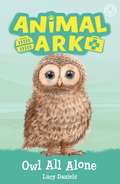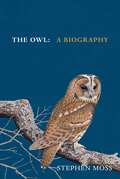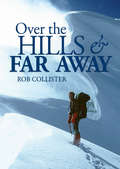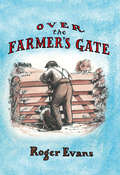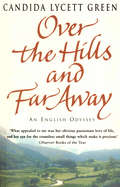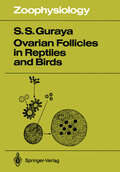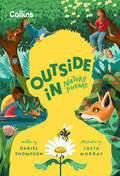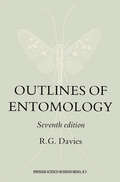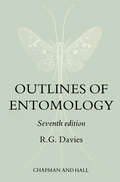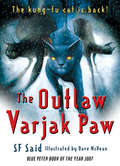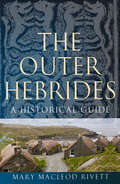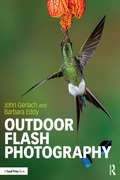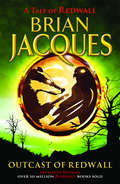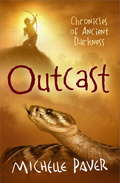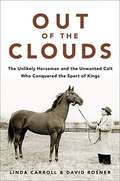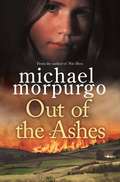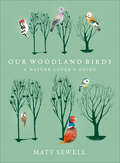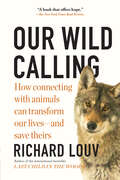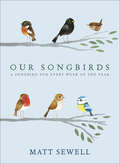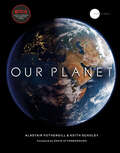- Table View
- List View
Owl All Alone: Book 12 (Animal Ark)
by Lucy DanielsHelping animals, having fun! The bestselling Animal Ark series has been reimagined for a new generation of children. Perfect for animal lovers and fans of Holly Webb and Magic Animal Friends. When Amelia and Sam find a lost white kitten in the wilderness, they can't work out why her behaviour seems different to other cats. With the help of the vets at Animal Ark, they work out that the lost kitten is deaf and help track down her owners. Because she can't hear, Tinkerbell is safer staying at home - but she really wants to explore outdoors. Can Amelia and Sam find a way to make the intrepid little kitten's garden safe but fun to play in?A brilliant animal series from multi-million-selling author Lucy Daniels, loved by parents and children alike!"I remember reading these books as a child myself. Now buying them for my own daughter. . . Delightful stories!" "I love this series of books. They made me realise how special animals are!"
The Owl: A Biography (The Bird Biography Series #5)
by Stephen MossFrom the renowned naturalist Stephen Moss, bestselling author of The Robin, The Wren and The Swan comes a new instalment in his beloved bird biography series. Uncover the secret life of owls through this beautiful guide to these secretive and charismatic birds. Owls are among the most mysterious birds in the world. Their hauntingly beautiful calls and mostly nocturnal habits have long captured our collective imagination, inspiring more superstitions, folktales and myths than any other group of birds. Seven species of owl - the tawny, little, barn, long-eared, short-eared, snowy and eagle owl - can be found in the British Isles (out of sixteen different kinds across Europe). They have lived alongside people for thousands of years, yet we still know so little about their day-to-day lives.Discover their fascinating lives, from the moment they first hatch, to the way they hunt their prey and how they raise the next generation. Explore the rich folklore they've inspired around the world and learn how, with a bit of luck, you can catch a glimpse of them yourself.With beautiful illustrations throughout, and expert birdwatching tips, this eye-opening biography reveals the hidden secrets of one of the world's most famous and beloved birds.
Oviraptor (UEB Uncontracted)
This is an image of an Oviraptor and an Oviraptor skeleton seen from the side and facing to the right. The number of bones in diagram of the skeleton has been reduced to make it easier to read tactually. There is a locator dot shown, which will be at the top left of the page when the image is the correct way up. A scale line stretches across the centre of the page. The Oviraptor was possibly one of the feathered dinosaurs. Its diet is unknown although some evidence points to it being carnivorous. It grew up to two metres in length. It is pictured here at the top of the page. At the left centre of the image is the dinosaurs long tail going to the right. To the right the dinosaurs body can be found with four legs at the bottom of the image. The two back legs on the left are much longer than the front legs on the right. It is thought to have been bipedal, walking on its back legs. At the far top right of the image is the Oviraptorâ TMs head with its distinctive crest. Like a modern bird, it did not have teeth. Only one of its eyes can be found. The Oviraptor skeleton: The image of the skeleton is at the bottom of the page. It is shown at the same scale and is posed in the same way as the picture up the page. At the centre left of the image is the dinosaurs tail going right to its pelvis. To the right again is its spine going right and up the page to its head. Only one of its eye sockets can be found. Its ribs are in the centre of the image and the bones of its legs can be found at the bottom of the page.
Oviraptor (UEB Contracted)
This is an image of an Oviraptor and an Oviraptor skeleton seen from the side and facing to the right. The number of bones in diagram of the skeleton has been reduced to make it easier to read tactually. There is a locator dot shown, which will be at the top left of the page when the image is the correct way up. A scale line stretches across the centre of the page. The Oviraptor was possibly one of the feathered dinosaurs. Its diet is unknown although some evidence points to it being carnivorous. It grew up to two metres in length. It is pictured here at the top of the page. At the left centre of the image is the dinosaurs long tail going to the right. To the right the dinosaurs body can be found with four legs at the bottom of the image. The two back legs on the left are much longer than the front legs on the right. It is thought to have been bipedal, walking on its back legs. At the far top right of the image is the Oviraptorâ TMs head with its distinctive crest. Like a modern bird, it did not have teeth. Only one of its eyes can be found. The Oviraptor skeleton: The image of the skeleton is at the bottom of the page. It is shown at the same scale and is posed in the same way as the picture up the page. At the centre left of the image is the dinosaurs tail going right to its pelvis. To the right again is its spine going right and up the page to its head. Only one of its eye sockets can be found. Its ribs are in the centre of the image and the bones of its legs can be found at the bottom of the page.
Oviraptor (Large Print)
This is an image of an Oviraptor and an Oviraptor skeleton seen from the side and facing to the right. The number of bones in diagram of the skeleton has been reduced to make it easier to read tactually. There is a locator dot shown, which will be at the top left of the page when the image is the correct way up. A scale line stretches across the centre of the page. The Oviraptor was possibly one of the feathered dinosaurs. Its diet is unknown although some evidence points to it being carnivorous. It grew up to two metres in length. It is pictured here at the top of the page. At the left centre of the image is the dinosaurs long tail going to the right. To the right the dinosaurs body can be found with four legs at the bottom of the image. The two back legs on the left are much longer than the front legs on the right. It is thought to have been bipedal, walking on its back legs. At the far top right of the image is the Oviraptorâ TMs head with its distinctive crest. Like a modern bird, it did not have teeth. Only one of its eyes can be found. The Oviraptor skeleton: The image of the skeleton is at the bottom of the page. It is shown at the same scale and is posed in the same way as the picture up the page. At the centre left of the image is the dinosaurs tail going right to its pelvis. To the right again is its spine going right and up the page to its head. Only one of its eye sockets can be found. Its ribs are in the centre of the image and the bones of its legs can be found at the bottom of the page.
Over the Hills and Far Away: A life in the mountains: From Snowdonia to the Himalaya (Ep Mountaineering Essays Ser.)
by Rob Collister‘The whole trail has been orchestrated to make it possible for each one of us, in different ways, to be “touched” by wilderness’Over the Hills and Far Away is a collection of essays that demonstrates Rob Collister’s thirty-year experience in mountaineering. From solo climbing in the hills of the Carneddau in Wales, to small group expeditions to Carn Etchachan, Forbes ridge and Grosshorn, Rob Collister can be found in the hills, whether it be running, climbing or skiing, inspired by the words of H.W. Tilman and Henry David Thoreau.This collection of essays tackles the theme of self-sufficient small group expeditions compared to the organised larger-sized ones, as well as displaying the timeless subject of litter disposal in summits by a fresh invasion of the mountains in Snowdonia and the conservation of the wilderness by the creation of schools such as Wilderness Leadership School.His sense of adventure is shown through his words and passionate descriptions, climbing out of conditions and finding a challenge in Alpine climbing. In Over Hills and Far Away we understand the importance of nature and appreciation of it. This book will expand your knowledge of modern world issues and it will leave you hungry for adventure in the hills.
Over the Farmer's Gate
by Roger EvansRoger Evans has built up a large cult following over the last 25 years with his hugely popular column in the Dairy Farmer, for which he won the prestigious PPA Columnist of the Year Award in 2000. He also has a huge following every Saturday in the Western Daily Press. An articulate Shropshire dairy and poultry farmer all his life, Roger Evans' lively prose sheds light on the joys and daily challenges of his work. He is well-informed, realistic and funny in his comments about all aspects of his life as a farmer today. Popular at all the agricultural shows and a hot-ticket as an after-dinner speaker, Roger is widely regarded as one of the best modern spokesmen for the British farmer.
Over The Hills And Far Away
by Candida Lycett GreenFrom her early childhood, when her inspirational mother would take her on trips along her beloved Ridgeway in a horse-drawn cart, Candida Lycett Green has retained a love of green lanes and tracks, of moving along at horse's pace and casting an eye on the beauty of England through the back door. Her insatiable appetite for exploring unknown territory has led her to travel all over the country by horse for weeks at a time, and often these journeys have come at important turning points in her life. Lyrical yet down-to-earth, framed by a recent 150-mile journey through Yorkshire and Northumberland with a friend, Over the Hills and Far Away dips back into past journeys by horse that also reflect her idyllic childhood in the bohemian Betjeman household, a charmed youth in the Swinging Sixties, a year-long honeymoon journey overland to India, early days at Private Eye, and the ups and downs of thirty-nine years of marriage and motherhood. Her story is made all the more poignant by her recent fight with breast cancer.
Ovarian Follicles in Reptiles and Birds (Zoophysiology #24)
by Sardul S. GurayaIn 1954, when I obtained my B. Sc. (Honours School) degree in Zoology, I was asked by my advisor, the late Professor Vishwa Nath, to make comparative cytological studies of oogenesis in birds for my M. Sc. (Honours School) thesis submitted to the Panjab University in 1956. Using the classical techniques of cytology, I studied the various aspects of follicle growth and atresia in five species of birds. Professor Vishwa Nath, who himself devoted most of his life to the study of the comparative cytology of gametogenesis in animals, was so much impressed by my findings on avian oogenesis that he asked me to continue my research work for the Ph. D. degree under his supervision. During my research work on avian oogenesis, I became very much interested in further comparative study of ovarian follicles in vertebrates and thus decided to make comparative, morphological and histochemical studies of ovarian follicles in reptiles, birds and mammals. Actually, very little information was available in this regard in 1957 when I started working for the Ph. D. degree. In subsequent years, I and my numerous dedicated and highly motivated M. Sc. and Ph. D. students con tinued to make comparative, morphological, histochemical, biochemical and physiological studies of ovarian follicles in all groups of vertebrates. In connection with the subject of this book, I would like to make special mention of my two brilliant students, namely Dr. S. K. Varma and Dr. R. K.
Outrageously Adorable Dog Knits: 25 Must-have Styles For The Pampered Pooch
by Caitlin Doyle Jill Bulgan Noelle Woosley Rachael Matthews Max AlexanderDogs can’t knit. But they sure can wear it well.
Outlines of Entomology
by R. G. DaviesThe present edition may be regarded as a descendant, much changed and greatly enlarged, of the late Dr A. D. Imms' Outlines of Entomology, first published in 1942. This went through three further editions without much change, but after the death of the original author a fifth, revised edition by Professor o. W. Richards and myself appeared in 1959 and a sixth in 1978. The book now appears in a considerably extended version in which I have tried to provide a more balanced introduction to the whole field of modern entomology by dealing with several aspects of the subject not discussed at all in previous editions. Thus, in addition to innumerable lesser changes in the sections on insect structure, function, development, classification and phylogeny, I have completely recast the earlier chapter on some important modes of life in insects. This now includes a far wider range of biological topic;s well exemplified by the insects and should, I hope, appeal not only to, those already dedicated to entomology but also to others with more general biological interests. A completely new chapter on the biology of insect populations has also been added and may serve to indicate the debt which modern ecological theory owes to work on insect populations. It should hardly be necessary to apologize for introducing a certain amount of elementary mathematics into this account of a subject which is now among the most highly quantitative of biological disciplines.
Outlines of Entomology
by R. G. DaviesThe present edition may be regarded as a descendant, much changed and greatly enlarged, of the late Dr A. D. Imms' Outlines of Entomology, first published in 1942. This went through three further editions without much change, but after the death of the original author a fifth, revised edition by Professor O. W. Richards and myself appeared in 1959 and a sixth in 1978. The book now appears in a considerably extended version in which I have tried to provide a more balanced introduction to the whole field of modern entomology by dealing with several aspects of the subject not discussed at all in previous editions. Thus, in addition to innumerable lesser changes in the sections on insect structure, function, development, classification and phylogeny, I have completely recast the earlier chapter on some important modes of life in insects. This now includes a far wider range of biological topics well exemplified by the insects and should, I hope, appeal not only to those already dedicated to entomology but also to others with more general biological interests. A completely new chapter on the biology of insect populations has also been added and may serve to indicate the debt which modern ecological theory owes to work on insect populations. It should hardly be necessary to apologize for introducing a certain amount of elementary mathematics into this account of a subject which is now among the most highly quantitative of biological disciplines.
The Outlaw Varjak Paw (Varjak Paw #2)
by Sf Said Dave McKeanHaving saved the city cats from a fate worse than death, Varjak Paw finds himself the elected and popular leader of a new gang - a gang that supports freedom and kindness for all. But will the pressure take its toll on this brave yet sometimes naive cat? Soon the city erupts in an all-out gang war as the evil Sally Bones attempts to control the lives of all cats. Horrified and outnumbered, Varjak and the others must fight for their freedom or die trying; can Jalal's Way really be the best way?This is another thrilling adventure, eagerly awaited by all Varjak fans, both young and old.
The Outer Hebrides: A Historical Guide
by Mary MacLeod RivettThe Outer Hebrides lie 40 miles to the west of mainland Scotland, forming a barrier to the North Atlantic. Culturally distinct from early prehistory, the islands contain a wealth of historical and archaeological monuments, including the standing stones at Callanish, the magnificent St Clement’s church at Rodel as well as numerous brochs, castles, Pitish houses, croft houses and industrial and military buildings.In addition to descriptions of key historic sites from prehistory onwards and gazetteers covering every place of historical interest, this book also traces the development of the modern environment and landscape of the islands, enabling the visitor to appreciate the sites within their historical and cultural context.
Outdoor Flash Photography
by John Gerlach Barbara EddyMaximizing the power of your camera’s flash is difficult enough in a studio set-up, but outdoors literally presents a whole new world of challenges. John Gerlach and Barbara Eddy have taken the most asked about subject from their renowned photography workshops and turned it into this guidebook that is sure to inspire your next outdoor shoot, while also saving you time and frustration. Outdoor Flash Photography covers a range of practices from portrait to landscape, including unique strategies that the authors have pioneered through 40 years in the field. Mastering the use of multiple flashes to freeze action is shown through one of most challenging subjects in nature, hummingbirds in flight. This book will benefit photographers of all experience levels who are eager to evolve their outdoor photography and get the most out of their equipment.
Outdoor Flash Photography
by John Gerlach Barbara EddyMaximizing the power of your camera’s flash is difficult enough in a studio set-up, but outdoors literally presents a whole new world of challenges. John Gerlach and Barbara Eddy have taken the most asked about subject from their renowned photography workshops and turned it into this guidebook that is sure to inspire your next outdoor shoot, while also saving you time and frustration. Outdoor Flash Photography covers a range of practices from portrait to landscape, including unique strategies that the authors have pioneered through 40 years in the field. Mastering the use of multiple flashes to freeze action is shown through one of most challenging subjects in nature, hummingbirds in flight. This book will benefit photographers of all experience levels who are eager to evolve their outdoor photography and get the most out of their equipment.
Outcast of Redwall: A Tale From Redwall (Redwall #8)
by Brian JacquesFerret Swartt Sixclaw and badger Sunflash the Mace are arch enemies who have sworn a pledge of death upon each other.Meanwhile, the Abbess of Redwall has banished a young creature from her Abbey. This harsh sentence forces a heart-breaking decision upon a young Redwall mousemaid and ultimately links her destiny to. . . . the Outcast of Redwall.
Outcast: Book 4 (Chronicles of Ancient Darkness #4)
by Michelle PaverThe dreadful secret that Torak carries with him at the close of SOUL EATER is revealed and he is cast out from the clans. It's his fourteenth summer. He's alone, cut off even from Wolf and Renn. Hunted and on the run he takes refuge in unknown territory - the haunted reedbeds of Lake Axehead, where he is menaced by the Hidden People. Other threats lurk nearby and his battle with the Soul-Eaters is far from over . . . As he fights for his life, Torak uncovers a deception too awful to contemplate, one that shakes him to the core and shatters his world.Launched at the height of the Harry Potter phenomenon, the Chronicles of Ancient Darkness is the ultimate magical adventure. This edition contains brand new interviews with Michelle Paver.Audio edition also available, read by Ian McKellen.
Out of the Clouds - Setting: The Unlikely Horseman And The Unwanted Colt Who Conquered The Sport Of Kings
by Linda Carroll and David RosnerHachette Books
Out of the Ashes
by Michael MorpurgoThis story is not a story at all. It all happened. On New Year's Day Becky Morley begins to write her diary. By March, her world has changed for ever. Foot-and-mouth disease breaks out on a pig farm hundreds of miles from the Morleys' Devon home, but soon the nightmare is a few fields away. Local sheep are infected and every animal is destroyed. Will the Morleys' flock be next? Will their pedigree dairy herd, the sows with their piglets, and Little Josh, Becky's hand-reared lamb, survive? Or will they be slaughtered too? The waiting and hoping is the most agonizing experience of Becky's life . . .
Our Woodland Birds: A Nature Lover's Guide
by Matt SewellBritain has some of the most beautiful woodland in the world, with some of the most beautiful inhabitants. All year round, the trees in forests, copses and wastelands offer our feathered friends food, shelter and a place to congregate and show-off. Now, in this beautiful follow-up to Our Garden Birds and Our Songbirds, street artist Matt Sewell captures Britain’s unique woodland life with his charming and distinctive illustrations. Featuring an array of enchanting scenes, from bramble-picking Blue Tits and a flight of Finches to a parliament of young Tawny Owls, Matt’s quirky, pop-art watercolours and whimsical descriptions express the individual characters of our woodland birds as never before. A delightful gift, this book will appeal to bird-watching enthusiasts, children, adults and art and design fans alike.
Our Wild Calling: How Connecting with Animals Can Transform Our Lives—and Save Theirs
by Richard Louv&“A book that offers hope.&” —The New York Times Book Review &“Richard Louv has done it again. A remarkable book that will help everyone break away from their fixed gaze at the screens that dominate our lives and remember instead that we are animals in a world of animals.&” —Bill McKibben, author of Falter Richard Louv&’s landmark book, Last Child in the Woods, inspired an international movement to connect children and nature. Now Louv redefines the future of human-animal coexistence. Our Wild Calling explores these powerful and mysterious bonds and how they can transform our mental, physical, and spiritual lives, serve as an antidote to the growing epidemic of human loneliness, and help us tap into the empathy required to preserve life on Earth. Louv interviews researchers, theologians, wildlife experts, indigenous healers, psychologists, and others to show how people are communicating with animals in ancient and new ways; how dogs can teach children ethical behavior; how animal-assisted therapy may yet transform the mental health field; and what role the human-animal relationship plays in our spiritual health. He reports on wildlife relocation and on how the growing populations of wild species in urban areas are blurring the lines between domestic and wild animals. Our Wild Calling makes the case for protecting, promoting, and creating a sustainable and shared habitat for all creatures—not out of fear, but out of love. Transformative and inspiring, this book points us toward what we all long for in the age of technology: real connection.
Our Songbirds: A songbird for every week of the year
by Matt SewellIn this beautiful follow-up to 2012's hit, Our Garden Birds, street artist Matt Sewell offers more watercolours and quirky descriptions of British songbirds.In Matt's world, the peewit sings the blues, and the bittern fills his neck 'like a tweed pair of bellows'. Distinctive and enchanting, with a songbird for each week of the year, this delightful gift book will appeal to birders, children and adults, and art and design fans alike.
Our Planet: And Our Planet's Surprising Future
by Fred Pearce Alastair Fothergill Keith Scholey________THE OFFICAL COMPANION TO THE GROUNDBREAKING NEW NETFLIX DOCUMENTARY SERIES‘The future of all life on this earth depends on our willingness to take action now’ - David Attenborough________With a foreword by Sir David Attenborough, breathtakingly beautiful still photography, specially commissioned maps and graphics, and compelling text expanding on the remarkable TV stories and giving the reader a depth of information that is impossible on screen, this companion to the groundbreaking NETFLIX series presents a whole new view of the place we call home. Featuring some of the world's rarest creatures and previously unseen parts of the Earth—from deep oceans to remote forests to ice caps—Our Planet takes nature-lovers deep into the science of our natural world.Revealing the most amazing sights on Earth in unprecedented ways, alongside stories of the ways humans are affecting the world’s ecosystems—from the wildebeest migrations in Africa to the penguin colonies of Antarctica—this book captures in one concise narrative a fundamental message:What we do in the next twenty years will determine the future of not just the natural world but humanity itself.If we don't act now to protect and preserve our planet, the beauty we're lucky enough to witness on these pages will have disappeared . . .
